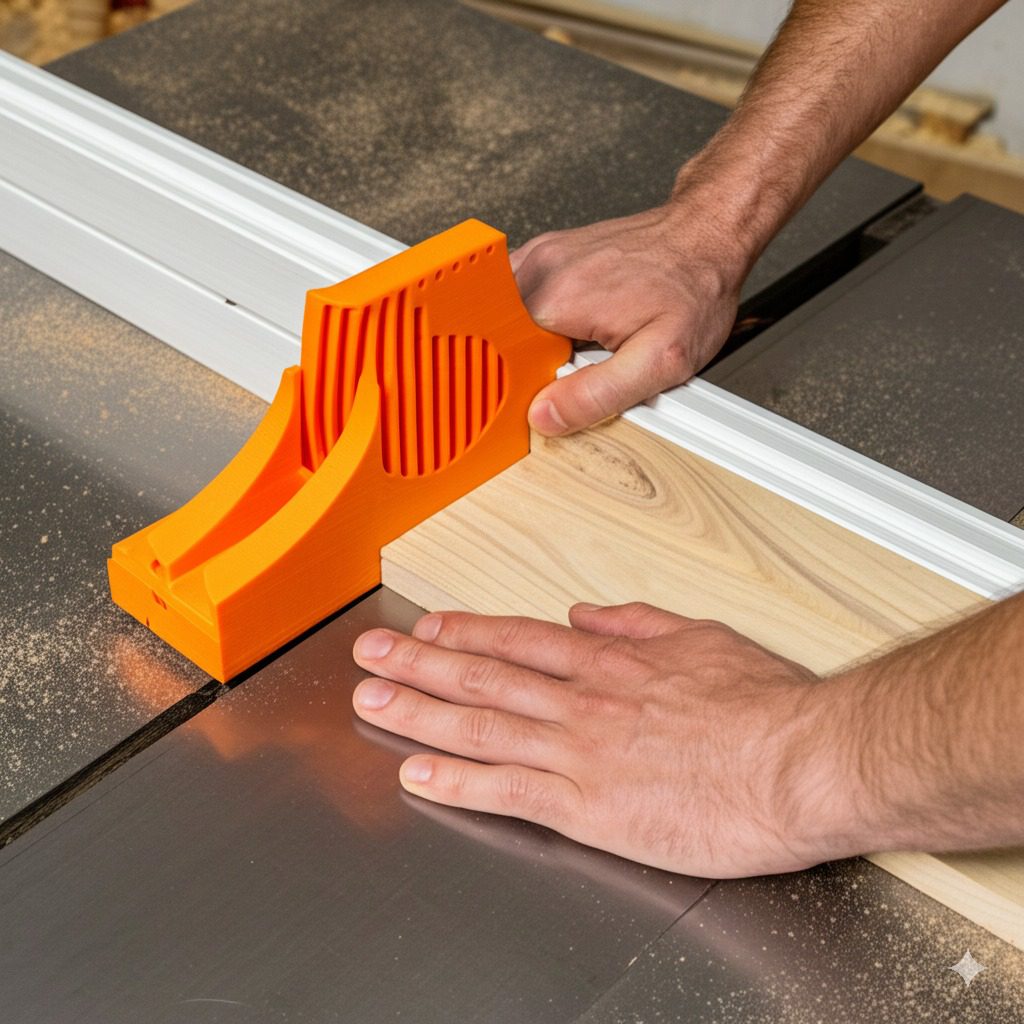Introduction
For woodworkers seeking precision and safety at the table saw, few accessories deliver the value of a quality featherboard. These simple yet ingenious devices have transformed woodworking by providing consistent pressure against workpieces, preventing kickback, and ensuring smooth, accurate cuts.
Featherboards serve as an extra set of hands in your workshop, applying steady pressure that keeps stock firmly against fences and tables. This pressure not only enhances cutting accuracy but dramatically improves safety by reducing the risk of dangerous kickback incidents.
This comprehensive guide explores everything you need to know about featherboards for table saws – from their construction and types to installation methods and recommendations for your specific cutting needs.
What Are Featherboards?
Definition and Purpose

Featherboards are woodworking accessories designed with angled, flexible “fingers” that provide continuous pressure against your workpiece during cutting operations. Their primary functions include:
- Maintaining consistent pressure against the fence or table
- Preventing dangerous kickback by restricting backward movement
- Improving cut quality by eliminating workpiece wobble
- Enhancing safety by keeping hands further from cutting tools
Types of Featherboards for Table Saws
| Type | Description | Best For |
|---|---|---|
| Standard Wood Featherboards | Traditional wooden design with hand-cut fingers | Basic operations, DIY projects |
| Commercial Plastic Featherboards | Molded high-density plastic construction | General workshop use, durability |
| Magnetic Featherboards | Uses powerful magnets to attach to cast iron surfaces | Quick setup, non-standard positions |
| T-Track Featherboards | Designed to fit standard T-tracks and miter slots | Precision work, repeatable positioning |
| Double Featherboards | Provides pressure from two directions simultaneously | Complex cuts, maximum stability |
Benefits of Using Featherboards
Safety Advantages
- Kickback Prevention: By applying forward pressure, featherboards prevent stock from being thrown back toward the operator
- Hand Protection: Maintains safe distance between hands and blade during cuts
- Control During Cuts: Reduces the need to apply manual pressure near cutting areas
- Material Stabilization: Prevents shifting during cuts, especially with smaller workpieces
Performance Improvements
- Precision Enhancement: Ensures consistent pressure for straighter, more accurate cuts
- Improved Surface Finish: Reduces vibration that can cause saw marks and imperfections
- Better Consistency: Maintains uniform pressure throughout the entire cut
- Repeatable Results: Helps achieve identical cuts across multiple workpieces
How to Install and Use Featherboards

Proper Positioning
The correct placement of featherboards is critical for both safety and performance:
- Fence-Mounted Position:
- Mount the featherboard on the fence just before the blade
- Fingers should point toward the feeding direction
- Apply moderate pressure – enough to hold the stock without impeding forward movement
- Table-Mounted Position:
- Place the featherboard in the miter slot before the blade
- Position it to press workpiece firmly against the fence
- Ensure it doesn’t interfere with pushing devices or stock movement
- Double Featherboard Setup:
- Use fence-mounted featherboard to press down on material
- Use miter-slot featherboard to press material against fence
- Ensure both provide firm but not excessive pressure
Installation Methods
![Installation Diagram: Shows proper positioning of featherboards relative to blade and workpiece]
Miter Slot Mounting:
- Loosen the adjustment knob on the featherboard base
- Slide the miter bar into the table saw’s miter slot
- Position the featherboard before the blade, never aligned with it
- Secure by tightening the adjustment knob
Fence Mounting:
- Select appropriate mounting hardware for your fence type
- Position featherboard along fence before the blade
- Ensure feathers point in the feed direction
- Tighten securely while maintaining proper pressure
Magnetic Mounting:
- Position magnetic base on cast iron table surface
- Activate the magnetic locking mechanism
- Adjust featherboard position and angle as needed
- Test holding power before proceeding with cuts
Best Practices for Featherboard Use
Safety Guidelines
- Never position featherboards alongside or after the blade
- Ensure featherboards don’t restrict the complete passage of stock
- Test pressure before cutting – material should move forward with moderate force
- Always use a push stick in combination with featherboards
- Release magnetic featherboards when not in use to preserve magnet strength
Application-Specific Tips
For Ripping Operations:
- Use a table-mounted featherboard to press the workpiece against the fence
- Position approximately 1-2 inches before the blade
- Ensure the last “feather” ends before the blade begins
For Dadoes and Grooves:
- Use dual featherboards for maximum control
- Set slightly lighter pressure to accommodate reduced material dimensions
- Consider specialized dado featherboards for repeated operations
For Thin Stock Processing:
- Use low-profile featherboards to accommodate material thickness
- Consider double featherboard setup for maximum control
- Increase finger flexibility for more delicate materials
DIY vs. Commercial Featherboards

Making Your Own Featherboard
Creating your own featherboard is a simple, cost-effective project:
Materials Needed:
- 3/4″ hardwood blank (maple or oak recommended)
- Bandsaw or table saw for cutting fingers
- Drill and appropriate hardware
Basic Construction Steps:
- Cut a piece of hardwood to approximately 5″ x 12″
- Mark a 25-30° angle across one end
- Cut 1/8″ wide fingers, leaving 1/4″ between cuts
- Sand all edges smooth, especially finger tips
- Drill mounting holes as needed for your specific setup
Leading Commercial Options
Top Recommended Featherboards:
- Magswitch Universal Featherboard
- Key Feature: Powerful magnetic base with on/off capability
- Best For: Quick setup and repositioning on cast iron tables
- Price Range: $50-70
Magswitch – 8110015 Table Featherboard Universal Model, Yellow
- Magwitch Universal Feather board : Works On Both Sides Of The Blade, And Even The Fence
- Low profile and double sided, this is the ultimate feather board from Magwitch
- Works to improve your cutting results on either side of the blade
New starting from: 74.00
Go to Amazon- Kreg PRS3010 True-FLEX Featherboard
- Key Feature: Dual-position mounting and consistent pressure design
- Best For: General-purpose use and budget-conscious woodworkers
- Price Range: $20-30
Kreg PRS3010 True-FLEX Featherboard – Single
- Premium Woodworking Tools: Kreg Featherboard applies perfect pressure to ensure safety and perfect cuts
- Perfectly Applies Pressure: Saw featherboard has carefully designed fingers to provide consistent, desirable pressure
- Durable Plastic Polymer Material: Hardy composite featherboard body works with a router table, table saw, miter-slot, or T-slot
New starting from: 37.49
Go to Amazon- Milescraft 3406 FeatherBoard
- Key Feature: Double-featherboard design for maximum control
- Best For: Complex cutting operations requiring multi-directional pressure
- Price Range: $25-35
- JessEm Clear-Cut Stock Guides
- Key Feature: Unique roller design that combines featherboard function with smooth stock movement
- Best For: Production environments and premium workshops
- Price Range: $100-130
Troubleshooting Common Featherboard Issues
Problem-Solving Guide
| Issue | Possible Cause | Solution |
|---|---|---|
| Workpiece binding | Excessive pressure | Reduce featherboard tension or reposition |
| Inconsistent cut quality | Insufficient pressure | Increase tension or add second featherboard |
| Featherboard slipping | Improper mounting | Check and tighten all mounting hardware |
| Difficulty feeding stock | Featherboard positioned incorrectly | Ensure fingers point in feed direction |
| Feather breakage | Using with hardwoods or excessive force | Replace with commercial featherboard rated for application |
User Experiences and Testimonials
“Adding featherboards to my table saw setup completely transformed my ripping operations. I get cleaner cuts, feel much safer, and have virtually eliminated kickback incidents.” – Thomas R., Furniture Maker
“As a woodworking instructor, I insist all my students use featherboards for their projects. The improvement in cut quality and reduced anxiety around the table saw is immediate and significant.” – Maria G., Woodworking Educator
“I was skeptical about magnetic featherboards until I tried one. The quick setup and repositioning has saved me hours in my small production shop, and the consistent pressure is perfect.” – James T., Cabinet Builder
Conclusion
Featherboards represent one of the most valuable and cost-effective additions to any table saw setup. Their ability to simultaneously enhance safety and improve cut quality makes them essential for woodworkers at every skill level.
Whether you choose to craft your own basic featherboard or invest in premium magnetic options, the benefits to your woodworking projects will be immediately apparent: straighter cuts, smoother edges, greater consistency, and significantly improved safety.
For the minimal investment required, featherboards deliver exceptional value – providing that crucial extra set of hands that helps transform good woodworking into great craftsmanship.
FAQ Section
Frequently Asked Questions About Featherboards
Q: Can I use featherboards with materials other than wood?
A: Yes, featherboards work well with many materials including plastics and soft metals, though pressure may need adjustment depending on material hardness.
Q: How many featherboards should I use at once?
A: For most operations, one or two featherboards are sufficient. Use one horizontal featherboard for basic ripping and potentially add a vertical featherboard for maximum control.
Q: Do featherboards wear out?
A: Wooden featherboards may eventually lose flexibility or break fingers with heavy use. Commercial plastic and rubber versions typically offer greater longevity.
Q: Can featherboards be used with other woodworking tools?
A: Absolutely! Featherboards are valuable accessories for router tables, bandsaws, and other machines where consistent pressure improves results.
Q: What’s the difference between cheap and expensive featherboards?
A: Premium featherboards typically offer better mounting systems, more consistent pressure, greater durability, and features like quick-release mechanisms or dual-direction pressure.

Finlay Connolly is a woodworking enthusiast and power tool specialist with over a decade of hands-on experience in the workshop. As the founder and lead writer at ProTableSawReviews.com, Finlay combines expert knowledge with real-world testing to help woodworkers, DIYers, and professionals choose the best tools for the job. With a sharp eye for detail and a passion for precision, Finlay is committed to providing trustworthy, practical advice backed by years of experience and research in the field. Whether you’re cutting dados or comparing fence systems, you can count on Finlay for honest, reliable reviews that make your next cut your best one.


